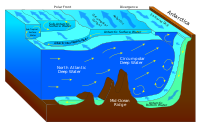
Photo from wikipedia
Eastward transport in the Southern Ocean is concentrated in jets associated with fronts in the Antarctic Circumpolar Current (ACC), whereas flow along the Antarctic continental slope is strongly westward in… Click to show full abstract
Eastward transport in the Southern Ocean is concentrated in jets associated with fronts in the Antarctic Circumpolar Current (ACC), whereas flow along the Antarctic continental slope is strongly westward in the Antarctic Slope Current (ASC). The dominant mesopelagic fish endemic to the Southern Ocean, Electrona antarctica (Günther, 1878), has been linked to Circumpolar Deep Water (CDW) transported by the ACC, and a modified version of CDW associated with the ASC. In conjunction with a regional-scale hydrographic survey south of the Kerguelen Plateau, we sampled fish from the ACC and ASC across Princess Elizabeth Trough off East Antarctica, and examined their otolith chemistry. Material laid down in the nucleus during early life showed heterogeneity, arguing against a single homogeneous population. Instead, it suggested exposure to different environments after hatching, consistent with separate transport pathways along the ACC and ASC. Despite clear differences between stations documented in the survey, material laid down along the edge did not show heterogeneity, suggesting instead exposure to similar environments. Seasonal movement northward by ASC fish into the ACC may explain both these results, and potential physical mechanisms include circulation in the Australian-Antarctic Gyre; northward movement of slope waters along the eastern margin of Princess Elizabeth Trough; and seasonal extension of sea-ice into the ACC. Such meridional movement would expose fish to zonal flow, eastward in the ACC during winter and westward in the ASC during summer, promoting regional retention as well as creating opportunities for mixing with fish transported along the ACC.
Journal Title: Marine environmental research
Year Published: 2018
Link to full text (if available)
Share on Social Media: Sign Up to like & get
recommendations!